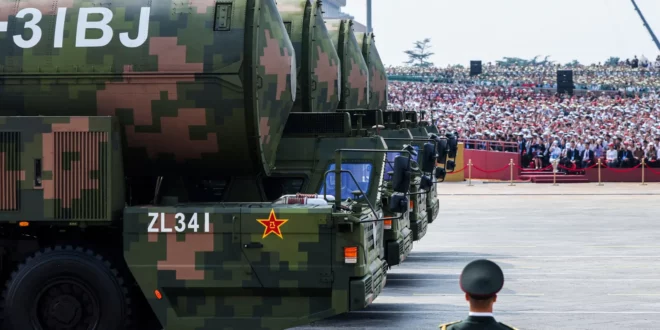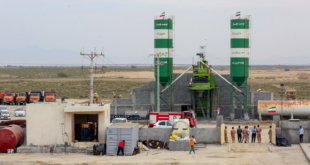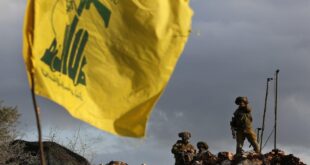Washington Must Adapt Its Playbook for a New Era of Nuclear Risk
In 1964, China detonated a 22-kiloton nuclear device at a test site in the arid northwestern Xinjiang region—and the political fallout reached Washington. Worried about the prospect that many countries around the world would soon gain nuclear weapons, U.S. President Lyndon Johnson convened a committee of seasoned foreign policy leaders to advise him on what Washington should do to prevent proliferation. Led by the former U.S. deputy secretary of defense Roswell Gilpatric, the group asked what an increase in nuclear-armed states would mean for U.S. security, what assurances the United States could realistically offer states that decided to forgo nuclear weapons, and how far Washington should go to prevent more states from acquiring them.
The Gilpatric committee’s conclusion was unanimous: averting the spread of nuclear weapons to any state, friend or foe, should be a top national security priority. To achieve that end, the committee provided a policy blueprint that Washington then went about implementing. Acting on the group’s advice, U.S. officials began negotiating multilateral nonproliferation treaties and agreements, including, controversially, accords with the Soviet Union. The United States also developed measures to cajole and coerce other countries into remaining nonnuclear, including extending security assurances, supporting civilian scientific endeavors, and threatening to cut off military support and impose economic penalties on proliferating states. Thanks in large part to such initiatives, U.S. efforts to combat proliferation over the last 60 years have succeeded more often than they have failed. Only nine states possess nuclear weapons, and only North Korea has acquired them in the twenty-first century.
But the nuclear landscape is changing in ways that are bringing proliferation back to the fore. An increasingly powerful China is scaling up its nuclear arsenal. Russia has backstopped its war in Ukraine with threats of nuclear use. Iran’s nuclear program was set back by recent U.S. and Israeli attacks, but it was not destroyed. U.S. allies, worried about their security and unsure about Washington’s commitment to their defense, are also mulling going nuclear. And evolving technologies such as artificial intelligence are making it easier than ever for states to build the bomb. Against this backdrop, the Cold War–era tools and tactics that Washington has long relied on to manage proliferation challenges are eroding. The international treaties and regimes that govern nuclear issues, particularly the Nuclear Nonproliferation Treaty (NPT), are badly frayed. Great-power cooperation on nuclear dangers has stalled.
These are storm clouds that American policymakers cannot ignore. So last year, drawing inspiration from the Gilpatric committee, we convened a bipartisan task force of senior national security leaders and experts to assess how nuclear proliferation is evolving and to make recommendations on how the United States can reinvigorate its approach. Despite differing views on a variety of security issues, the group, like Gilpatric’s, reached a clear consensus: nuclear proliferation by any additional country would diminish U.S. power, complicate strategic planning, and increase the likelihood of nuclear use, accidents, and disasters.
But preventing proliferation will require a revamped approach. Instead of relying extensively on international treaties and great-power cooperation to control the supply of nuclear technologies, Washington will need to focus more on reconfiguring security alliances and pursuing new risk-reduction measures, including with competitors, that curtail the demand for nuclear weapons. The U.S. government will have to reassure its allies that it will come to their defense and harness new technologies, such as artificial intelligence, that can strengthen international monitoring capabilities and make it harder to conceal illicit activities.
None of these steps will be easy, given the world’s many divisions. But they are essential to preventing the emergence of new nuclear states—and thus enormous new risks.
THE TRIPOLAR MOMENT
The Soviet Union and the United States agreed on little. But throughout the mid-to-late twentieth century, the two countries sustained a high degree of cooperation in establishing and enforcing a global network of treaties, institutions, technology controls, and practices to inhibit nuclear proliferation. The cornerstone of this system is the NPT, which opened for signature in 1968 and now enjoys close to universal membership. Moscow and Washington upheld nonproliferation cooperation across all kinds of ups and downs in their relationship, including after the Cold War ended.
China was historically more skeptical of nonproliferation institutions and policies. But after joining the NPT in 1992, it also began participating, albeit selectively, in efforts to avert the further spread of nuclear weapons. For example, China, Russia, and the United States cooperated to stop North Korea’s nuclearization during the 1990s and early 2000s, although they ultimately failed. They later partnered with European powers to negotiate and implement the 2015 nuclear deal with Iran. This successfully limited Iranian enrichment of uranium—until U.S. President Donald Trump withdrew from the accord three years later.
But recently, both Moscow and Beijing have begun to dial down their efforts. To advance its war against Ukraine, Russia has embraced military cooperation with both Iran and North Korea. In exchange for their support, it has ignored Tehran’s and Pyongyang’s nuclear advances, voting in international forums to protect Iran from censure and bartering for North Korean weapons in violation of a UN arms embargo on North Korea. More concerning, Russian nuclear saber rattling has reanimated concerns in Europe and elsewhere that revisionist powers might use nuclear coercion to pursue wars of aggression. In 2023, Russian President Vladimir Putin announced that he was suspending Moscow’s participation in the New START treaty, which was negotiated with the United States in 2010 and is the last remaining bilateral agreement governing strategic nuclear arsenals. For now, Russia continues to adhere to the treaty’s central limits, and Putin recently offered to extend those limits for an additional year. But the details of what Russia has proposed, let alone what it will do, remain unclear, and the prospects of a successor treaty to replace New START when it expires in early 2026 appear dim. It is now common to hear people in Kyiv and other European capitals say that only the bomb can guarantee a state’s survival.
China’s rapidly expanding nuclear arsenal and more aggressive regional military posture add yet another layer to this challenge. What has historically been a bipolar nuclear order is transforming into a tripolar one. Beijing and Washington share common interests in preventing other states from developing nuclear weapons, but they have far less experience cooperating on nuclear issues than Moscow and Washington do. Moreover, Beijing likely sees solidifying a geopolitical counterweight to the United States and its allies as more important than preventing Iranian proliferation or reining in North Korea’s nuclear expansion.
KEEP YOUR FRIENDS CLOSE
Like its adversaries, many allies and close partners of the United States have flirted with the idea of acquiring nuclear weapons. In fact, many of Washington’s greatest nonproliferation success stories involved these states. American officials used a variety of tools to stymie their nuclear weapons ambitions, but one of the chief instruments was a willingness to extend protection to allies by bringing them under the U.S. nuclear umbrella. These arrangements played a crucial role in preventing the wave of proliferation that appeared imminent in the 1960s and 1970s. In practice, this involves maintaining a large defense and security network in key regions, including the forward deployment of U.S. nuclear weapons in Europe.
The U.S. alliance system is expensive, but it has done much to help Washington. U.S. officials have long believed that it would be harder to manage crises and prevent the use of nuclear weapons if more partners acquired nuclear arsenals. Extending deterrence has also afforded Washington significant influence over security dynamics in East Asia and Europe, where the United States has used its nuclear umbrella to cultivate valuable economic, political, and military relationships.
Yet growing threats from China, North Korea, and Russia have made U.S. allies question the credibility and sustainability of the security umbrella, particularly given the recent shifts in U.S. policy. Although doubts about whether the United States would truly risk nuclear war on behalf of its allies have always existed, such concerns have deepened in light of Washington’s costly trade disputes, its criticisms of allies’ “free-riding,” and its discussions on reducing the U.S. military presence abroad. These allies are also unsettled by Washington’s periodic overtures to long-standing adversaries, particularly Russia. As a result, in recent years, current and former leaders and prominent security analysts in a variety of U.S. partner countries—including Germany, Japan, Poland, Saudi Arabia, and South Korea—have openly discussed the need for independent nuclear arsenals or alternative security arrangements that would reduce their dependence on the United States.
The United States can encourage its allies to invest more in deterrence.Some American analysts and officials have argued that the prospect of nuclear weapons acquisition by select allies may not be so bad and that it would help reduce the United States’ defense burden and vulnerability to a nuclear attack. But in reality, nuclear proliferation by U.S. allies could trigger destabilizing reactions from adversaries, increasing the likelihood of escalating regional conflicts. It could also make it harder for the United States to influence the behavior of allies and undercut efforts to thwart the nuclear weapon ambitions of unfriendly states, such as Iran.
Rather than encourage allies to develop nuclear weapons of their own, Washington should work with them to develop a new extended deterrence compact by updating the basic security bargains and divisions of labor that provide for mutual defense. Such an agreement should retain the U.S. nuclear umbrella for strategic deterrence while strengthening the conventional defenses of allies so they are better equipped to handle military threats from China, North Korea, and Russia. In turn, allies must better understand that their conventional military forces and American capabilities, conventional and nuclear, are part of one system for deterring threats and responding to attacks.
The United States can encourage its allies to invest more in deterrence by pairing steps to reinforce U.S. commitments with reciprocal and timely contributions from partners. Many allies are already increasing defense spending and augmenting their military capabilities, but this is only a start. In terms of hardware, allies need to acquire additional military systems, including conventional strike capabilities and integrated and layered missile defenses, that complement U.S. capabilities. Nonnuclear weapons have more range and utility than they did when extended deterrence arrangements were first established during the Cold War; as a result, they can serve as the first line of defense against aggression. But these countries must also invest in newer systems, such as anti-drone weapons. Recent events, including the incursion of Russian drones into Polish and Romanian airspace this month, underscore the urgency of adjusting to evolving forms of warfare. Poland, for example, was able to shoot down the drones, but only by scrambling its fighter jets. And relying on expensive missiles and planes to intercept cheap drones is not sustainable.
Equally critical, the United States and its allies must improve military and political coordination. Tokyo and Washington’s decision last year to elevate alliance discussions on extended deterrence to the highest levels of government is a positive step in this direction. Deeper coordination to prepare for nuclear crises would also help allies understand how their contributions are critical to deterrence and increase their confidence that the United States would take action on their behalf. Washington can further reassure its friends by repeatedly and publicly reiterating its commitment to protect them.
COMMON GROUND
As it strengthens its alliances, the United States should also pursue pragmatic engagement with China and Russia to mitigate proliferation. The most direct way to do this would be for the three countries to engage in arms control and risk-reduction efforts. But realistically, the prospects for significant progress today are slim. Attempts to engage China and Russia in recent years have borne little fruit. Engaging with Russia is likely to be especially difficult as long as the war in Ukraine continues. And even if the United States suddenly found receptive partners in Beijing and Moscow, the emergence of a tripolar nuclear order calls for a fundamentally different approach to arms control. Attempting to equalize nuclear capabilities across the three powers cannot work.
The United States should nevertheless seek openings where it can. To begin, Washington should take up Putin’s suggestion to maintain the existing caps on their respective nuclear arsenals, which will otherwise be lifted when the New START treaty expires. U.S. officials should also propose a longer extension to New START while negotiators work on an agreement to replace it. In parallel, a senior U.S. official should signal to Chinese counterparts that Washington would be willing to discuss issuing a public statement in which the United States and China recognized their mutual nuclear vulnerability—a concept that has underpinned the nuclear relationship between Washington and Moscow for decades—as the first step in a bilateral process to identify and reduce nuclear risks. Separately, China, Russia, the United States, and the world’s other recognized nuclear weapons powers could jointly commit not to use, or threaten to use, nuclear weapons against countries that do not have them. This would demonstrate nuclear restraint and perhaps reduce the incentives for countries to seek nuclear weapons.
Both China and Russia can make unique contributions to preventing the spread of nuclear weapons. As a close neighbor and key transit point for illicit North Korean activities, China could, for instance, step up efforts to uphold the UN arms embargo on North Korea. It could also address concerns about its own opaque and rapidly expanding nuclear arsenal. As the United States should tell China (behind closed doors), its nuclear buildup is stoking security anxieties in Asia and leading other countries in the region to contemplate developing their own nuclear weapons.
China, Russia, and the United States have reason to cooperate on nuclear security.Russia was particularly integral to negotiating and implementing the 2015 Iran nuclear deal, and it has powerful leverage as the primary supplier to Iran’s civilian nuclear program. Should it choose to, it could help push Tehran into a new nuclear pact with limits and monitoring mechanisms that go beyond what was in the original. But even if Moscow won’t use its power to force through a new agreement, the United States can enlist Russia’s help in preventing the present situation from getting worse. Moscow could, for instance, press Tehran to fully restore its cooperation with the International Atomic Energy Agency, which requires that Iran provide unimpeded access to inspectors, and avoid escalatory actions such as withdrawing from the NPT.
China, Russia, and the United States have reason to cooperate on other elements of nuclear security, even if they do not directly address rising proliferation threats. The states are all leaders in civilian nuclear technologies, with ambitious goals to expand nuclear energy projects domestically and abroad. Even as they compete for contracts and influence in the nuclear export marketplace, they maintain shared goals. Washington should therefore seek reinvigorated technical dialogues on promoting high standards for nuclear security and making sure that nuclear materials do not fall into the hands of smugglers or terrorists.
Addressing the intersection of nuclear proliferation and emerging technologies will also require global buy-in, including from China and Russia, and the updating of international safeguards and multilateral export regimes. Already, powerful AI models can be exploited by states to weaponize nuclear materials more quickly and cheaply or to circumvent monitoring and verification. Other developments, such as 3D printing and specialized machine tools, have likewise reduced some of the technical chokepoints to proliferation. At the same time, the United States and other countries can and should harness emerging technologies to thwart proliferation more effectively. Cheaper and more advanced sensor technologies could aid in the detection of illicit nuclear activities, making it harder for proliferators to hide.
ACROSS PARTY LINES
Fortunately, the vast majority of states still do not want nuclear weapons—in no small part because of the successes of U.S. strategy. But if even a handful of governments pursue the bomb, the world will be more volatile and dangerous. The United States thus retains an abiding interest in curtailing nuclear proliferation. American policymakers, after all, do not want to live in a world in which they must neglect key security priorities, such as homeland defense and technological competition, to focus on nuclear crises.
But to stop the further spread of nuclear weapons, Washington must address the rising interest in the bomb among its allies and bear in mind evolving threats from new technologies. It needs to bring Cold War–era security commitments into the twenty-first century, making them more reciprocal and responsive in ways that can mitigate allies’ fears of abandonment, strengthen collective defenses, and make U.S. defense burdens more sustainable. American strategy also needs to reflect a tripolar nuclear order. In the past, U.S. cooperation with Russia could focus mostly on building up the nonproliferation regime. Today, Washington will need to push Beijing and Moscow to temper behaviors that are driving countries to consider nuclear weapons of their own.
Averting proliferation in this geopolitical moment may seem difficult, and it will indeed require strong, bipartisan support to update U.S. strategy. But consensus is within reach when it comes to halting the spread of nuclear weapons, if only because the alternative would be far more costly for the United States and the world.
 Eurasia Press & News
Eurasia Press & News




